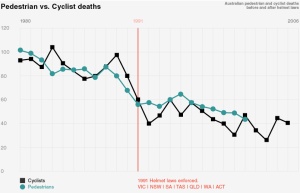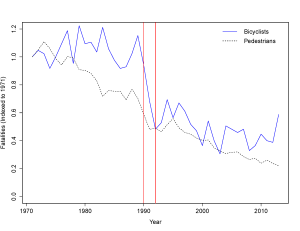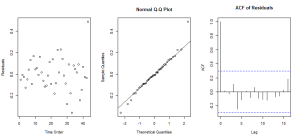I recently came across another excellent cycling article from Alan Davies at The Urbanist. In the article, Davies discusses claims that cycling accidents are on the rise. This is due to an increase in the cycling road toll in 2013. This may be a concern, but it’s impossible to establish a trend from one data point.
Davies briefly mentions helmet legislation, but notes it isn’t relevant to the current discussion (and I agree). However, in the comments, I found a few troubling responses regarding that topic. Strewth states
But we also know from analysis done in the 1990s that among cyclists, the decline in non-head injuries over this period was as great or greater than the decline in head injuries.
No citation or link is given to support this claim. This comment is strange since a previous study of mine estimates a 35% drop in cycling head injury hospitalizations with the NSW helmet law while arm and leg injuries dropped by only 11% and 6% respectively. A more comprehensive response was left by Linda Ward.
Another comment by Nik Dow states
A fact-based explanation is linked (see “detailed explanation”) http://www.freestylecyclists.org/do-helmet-laws-make-much-difference/ and covers the introduction of demerit points and ramping up of speed and red-light cameras.
The link takes you to Freestylecyclists.org, an anti-helmet organization I’ve discussed previously. My previous post pointed to misinformation presented by national spokesperson Alan Todd and the given link is more of the same.
The following plot of cycling and pedestrian fatalities from 1980-2006 in Australia is given and the anonymous author concludes declines in cycling deaths were mostly “due to massive ramping up of speed and red-light cameras, together with the introduction of demerit points.” I’ve assumed this is due to the pedestrian and cycling time series being placed on top of each other.
What is problematic here is this is not an accurate representation of the fatality data (much of it can be found here). The author has apparently rescaled the pedestrian time series to get them to overlay. As I’ve discussed before, this a strategy too often used to mislead actual temporal relationships of data. In the comments, Davies also questions the accuracy of this figure.
Plotting both time series on the same graph is problematic here since pedestrian fatalities have historically dwarfed those for cyclists (in 1989 they were 501 and 98 respectively). One method to address this problem is to index the time series to a starting value. An advantage of this approach is you’re able to plot trends without distorting scales; however, a disadvantage is the actual data is not being presented and each data point is a comparison with some starting value.
Below is such a plot for the period 1971 to 2013 for cycling and pedestrian fatalities in Australia (the vertical red lines represent the first and last helmet law dates in Australia).
This looks virtually nothing like the Freestylecyclist.org plot. Relative to 1971, pedestrian fatalities have steadily declined over the next 40 years, while cycling fatalities were flat up to the 1990, followed by a substantial decline by 1992 and flat thereafter. This does not suggest declines in cycling fatalities are associated with general road safety improvements such as demerit points or speed cameras. Further, the lack of temporal agreement between cycling and pedestrian fatalities prior to 1990 raises questions regarding pedestrians as a suitable comparator to cyclists.
It is not appropriate to make decisions about trends from eye-balling a figure, so I fit an interrupted time series model to this data. The Poisson model I used was
where TIME is centered at 1991 and LAW is an indicator that takes on the value 1 for years 1991 onwards and 0 everywhere else. My results suggest no pre-1990 trend for cycling fatalities (p=0.84) and a 42% decline in cycling fatalities at 1991 (p<0.001). Residual plots indicate good overall fit, although the 2013 observation may exhibit high leverage.0000
Something profound happened for cycling fatalities in Australia between 1990-1992. It is often argued helmet legislation deters cycling; however, this is an argument I largely reject due to conflicting evidence from data of low quality.[1] Still, this does not necessarily indicate helmet legislation is a causal factor in lowering cycling fatalities. Yet, this analysis does rule out general road safety interventions as a causal influence proposed by Freedomcyclists.org.
- Olivier, J., Grzebieta, R., Wang, J.J.J. & Walter, S. (2013). Statistical Errors in Anti-Helmet Arguments. Australasian College of Road Safety Conference.


